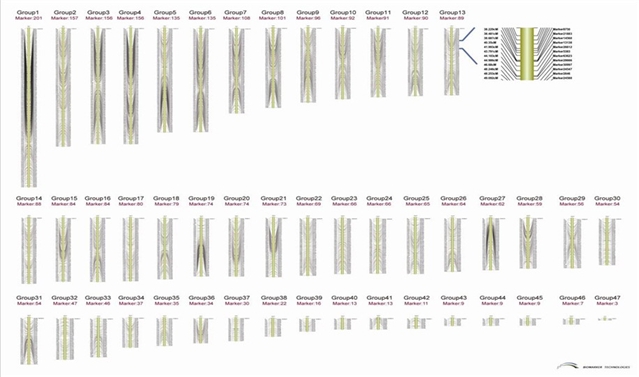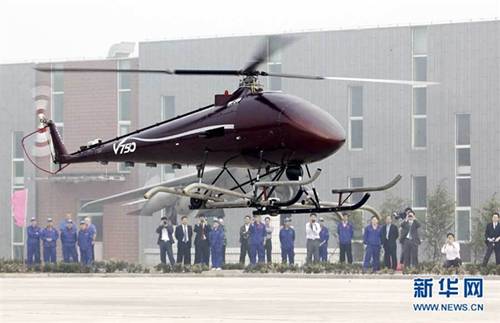CHINA SCIENCE AND TECHNOLOGY
NEWSLETTER
The Ministry of Science and Technology
People's Republic of China
|
|
|
N0.618 |
May 10, 2011 |
|
|
|
|
|
|
|
|
IN THIS ISSUE
|
|
*China-Switzerland Joint S&T Statement
*China and Australia Exchange Young Scientists
*China Launched Meridian Probe
*Carp Genome Sequenced
*Home Made Unmanned Helicopter
* China's First HIV Saliva Test Kit
* China’s First Hepatitis B Gene Bank
|
|
INTERNATIONAL COOPERATION |
China-Switzerland Joint S&T Statement


WAN Gang, Chinese Minister of Science and Technology, met with Didier Burkhalter, Swiss Federal Councilor and Interior Minister, on April 25, 2011 in Beijing. WAN and Burkhalter jointly undersigned a statement on S&T cooperation between the two countries. The statement reviewed the accomplishments made under the China-Switzerland S&T Cooperation Program (SSSTC), and reached consensus on promoting and encouraging future collaborations between the two countries, especially in the area of life sciences and health.
China and Australia Exchange Young Scientists
A 2011 China-Australia Young Scientist Exchange Program was recently kicked off in Beijing. CHEN Heping, Deputy Director of China Science and Technology Exchange Center, and Emma Afterman, a Second Secretary of Australian Embassy in Beijing made their opening remarks at the ceremony. Representatives from the Chinese Ministry of Science and Technology, the National Natural Science Foundation, and the Chinese Academy of Sciences briefed the audiences of the background information and associated projects. Eight young scientists dispatched by Australia for the exchange program, and the representatives from Tsinghua University, CAS Institute of Automation and others also attended the opening ceremony.
The exchange program was created under an accord to exchange young scientist between China and Australia jointly inked by the Chinese Ministry of Science and Technology and the Australian Ministry for Science, Education, and Training during Chinese Premier Wen Jiabao's visit to Australia in April 2006. The program was designed to promote the exchanges of young scholars between the two countries, enhancing mutual understanding and friendship, and encouraging the participation of young scientists in cooperative research activities, in an attempt to lay the ground for the long-term cooperation between the two countries. According to the accord, each country will send eight outstanding young scientists to work on the priority areas in the opposite country for two weeks on annual basis. The eight young scientists dispatched by Australia this time will work with the researchers at Tsinghua University, Chinese Academy of Sciences Dalian Institute of Chemical Physics among others.
China Launched Meridian Probe
A "Meridian Project", initiated under the National Major S&T Infrastructure Program to monitor the meridian chains from the ground bases on the east hemisphere, was successfully launched on May 7, 2011 from a CAS launching site in Hainan. The "Eagle 3C" probe aboard with a radiosonde system was blasted off on May 7, at 7:00 from a launching site in Hainan, along the direction of 45 degree northwest and at an angle of 87 degree. 43 seconds after blasting off, the launching rocket rose to a height of 60 km, where the head was separated from the body, and the electric field instrument started to stretch out its rods. The rocket hit the height of 65km, three seconds later, allowing the Langmuir probe to stretch out its rod and be unlocked. The rocket reached the orbit vertex at 196 km, 215 seconds after the launch, and re-entered the atmosphere with a completed flight mission 420 seconds after the launch.
The Kunpeng-I radiosonde has a range of impressive payloads, including the dual-arm electric field probe, atmospheric tracers probe, and the Langmuir probe, along with the utility equipment, including on-the-rocket launch system, attitude meter, and high dynamic GPS receivers. The dual-arm electric field probe and the Langmuir probe, jointly developed by Chinese, Austrian, and Italian scientists, were employed for the first time in domestic space probe activities.
Up to date, the "Meridian Project" has established 15 ground based space environment monitoring stations along 120 degree east and 30 degree north. The radiosonde division in Danzhou, Hainan is a comprehensive monitoring station enjoying most needed functionalities.
Carp Genome Sequenced

High-density genome chain map of common carp.
A Cyprinidae genome workshop and associated briefing event was held on May 6, 2011 in Beijing. The project, jointly undertaken by the Research Center for Applied Aquatic Genomics, part of the Chinese Academy of Fishery Sciences, Heilongjiang Institute of Fishery, and CAS Beijing Genomics Institute, has completed the genome-wide sequencing of carp, and mapped out the genome framework, physical genome map, and high-density chain map of common carp, which creates an important basis for genome-assisted breeding and fast breeding.
The released carp genome framework map is built on the high-quality data 100 times the coverage collected from the most popular individual gynogenetic carp species in China.CAS Beijing Genomics Institute has completed the mapping of carp’s whole genome, using advanced data assembly techniques, including the whole-genome shotgun method. Carp genome has a size of 1.7Gb, and a Scaffold N50 length of 404kb. In addition, the efforts have resulted in more than 70,000 carp BAC clone end sequences, 1,66 million expressed sequence tags, and a physical genome map made up of more than 80,000 BAC clones. The framework map has covered 96.5% of the BAC end sequences, 96.2% of the expressed sequence tags, and 95% of the physical map, respectively.
Gastric Cancer Metastasis Hub Found
XUE Yingwei, Director of Gastrointestinal Division of Harbin Medical University No. 3 Clinical School, found that Twist is a hub triggering up the malignant behavior of gastric cancer, including invasion and metastasis,. Researchers spotted the “hub” through screening the protein levels of Twist in four gastric cancer cell lines, under a study made to understand the early signals of gastric cancer formation.
Researchers created a technically proven rat gastric cancer model, in which they measured gene expression product of COX-2, and identified its role in triggering up the formation of gastric cancer. Meanwhile, they confirmed that the pathway of hepatocyte growth factor (HGF) and vascular endothelial growth factor (VEGF) is closely associated with the biological behaviors of gastric cancer cells, including growth, adhesion, migration, and invasion.
The study also found that as a marker of epithelial and interstitial cells, and a molecule related to the cancer invasion and metastasis, Twist protein makes a hub for regulating the invasion and metastasis of gastric cancer. Researchers proved the internal ties between Twist protein and the invasion, migration, and drug-induced apoptosis of gastric cancer, and its ties with cell cycles as well, using advanced molecular biological means, including plasmids construction and small RNA fragments interference. The finding provides new theoretical evidence for the targeted treatment of advanced gastric cancer and curbing the peritoneal metastasis of gastric cancer.
Home Made Unmanned Helicopter


A V750 helicopter, the largest unmanned helicopter in the country jointly developed by Weifang Tianxiang Aviation Industry and Qingdao Haili Helicopter, made its successful maiden flight in Weifang on May 7, 2011. Converted from a two-seat manned B2B airplane, the unmanned model is designed with a takeoff weight of 757kg, a payload up to 80kg, and the maximum level flight speed up to 161km per hour over a maximum range up to 500 kilometers for 4 hours or longer. The airplane can be operated either by remote manual control, or by programmed control, allowing a switch between the two operating modes during the flight. The unmanned helicopter sits in a control radius up to 150 kilometers, and a height ceiling up to 3,000 meters.
V750 is a versatile unmanned helicopter designed to land on simple airstrips, field sites, or on ship decks, carrying mission equipment. The helicopter can be employed to conduct all-time aerial photographing, reconnaissance, and surveillance of a given target, either fixed or mobile, on land or on the sea, and the evaluation of the damages on the ground, desirable for forest fire monitoring, high-voltage power line inspection, coastal boats monitoring, and marine or mountain rescue missions.
China's First HIV Saliva Test Kit
An HIV (1 +2 type) test kit working on oral mucosal exudate antibody, jointly developed by Beijing Wantai Biopharmaceuticals and Xiamen University, is able to tell if the testee has been affected by AIDS in 30 minutes, simply by collecting the saliva sample using a cotton swab, and testing it in a kit made up of several reagents. Built on the immunogold filtration assay, the saliva test kit is easy to operate, without causing pains or injury to testees as the traditional needle sample collection method would do, greatly reduced possible infection risks to both health care workers and testees. The test kit is applicable to the people who are inappropriate for venous blood collection, including children and people suffering obesity and venous atrophy. It can also be applied to screen AIDS patients in the remote areas with poor medical conditions for blood sample collection, or screen a large population. The test kit has been approved for market.
Before this, the test kit has been clinically tested at China Center for Disease Control and Prevention, Chinese Academy of Military Medical Sciences, and Xinjiang Center for Disease Control and Prevention. Researchers also collected 1,271 saliva samples from high-risk groups in the country. The final clinical examination revealed a 99.09% positive compliance, a 99.79% negative compliance, and a 99.61% total compliance in line with the imported ELISA HIV test kit.
China’s First Hepatitis B Gene Bank
Not long ago, a multi-functional sharing database of hepatitis B viruses, the first of its kind in the country, was established and put into use at the PLA 302 Hospital, The database has collected the information on hepatitis B virus gene sequence and gene cloning, and clinical data of more than 10,000 hepatitis B patients, making itself a powerful biological information analysis platform for studying drug resistance, molecular pathogenesis, vaccine design, and immune response, in addition to being a useful platform for preparing optimal therapeutic plans for the patients.
According to a briefing, the database, enjoying the merits of massive sequence data and free data resources sharing, can be used to detect and monitor nucleoside (acid) antiviral drugs resistance. The database is also scalable for collecting new clinical data and sequence information. The database has so far collected more than 2,000 typical virus genes, and associated information and indicators on drug resistance mutation, antiretroviral treatment, and clinical response.
The database is also designed with a range of bioinformatics analysis functions, including sequence similarity alignment, subtype analysis, HBV serotype analysis, nucleoside analogue resistance locus analysis, specific T lymphocyte epitopes, viral genome phylogenetic tree analysis, and personalized data filtering analysis. It is able to work on the statistics of the sequence polymorphisms of HBV functional areas at different lengths, from the levels of nucleic acids and proteins. Having been tested at medical and research institutions, and achieved the desired results, the database has been officially put into online operation.
Core Components Tested in Deep Sea
A proprietary home made core component designed to establish a seabed observation network was successfully deployed in the late April in Monterey Bay, and officially connected to the U.S. submarine observation network. At this point, the submarine observing network connection box and camera system developed by the Zhejiang University, the undersea in-situ chemical analysis system developed by Tongji University, and the China node made up of an undersea physical in-situ analysis system developed by Ocean University of China, are smoothly collecting the environmental data at a depth of 888m in Monterey Bay.
Thanks to the 3-year technical research and development, the project team, led by Tongji University, has landed a number of breakthroughs in developing the core technologies for the seabed observation network, and developed prototype submarine connection box, underwater in-situ chemical and dynamic environment monitoring system, and supporting software. The tests made in the shallow water last September confirmed the operational applicability of the key technologies, including real-time submarine monitoring and information transmission, and submarine connection box’s information fusion and processing capability. The deep-sea tests made this time has validated the applicability of the communication capability of the connection box, underwater in-situ ion chromatography analysis, seabed chemical environment monitoring, submarine dynamic environment monitoring, database and online publishing techniques, and system integration.
Improved Pump Test Technology
A project, assigned to GMPI under the National S&T Support Program for the 11th Five-year period (2006-2010) to work on key pump test technologies, has recently passed an acceptance check. The project team Conducted a range of tests, including internal flow test, tracer particle test, induced noise test, vibration and pressure pulse fluctuation test, and new diffuser/tip clearance test. They also established a mathematical model for observing the tracer particles in the turbulent flow field of a centrifugal pump, and developed the techniques applicable to PIV test. In addition, researchers rolled out a full-featured pump test based four quadrants test system, allowing the tester to know the pump-wide working conditions and operation, making the maximum utilization of the pump's potentials. The results stemmed from the project provide technical solutions to raising the reliability and energy saving capability of the pump. The advanced test technology has found applications in the million-ton PTA system and boat life support system.
Comments or inquiries on editorial matters or Newsletter content should be directed to:
Department of International Cooperation, MOST 15B, Fuxing Road, Beijing 100862, PR China Tel: (8610)58881360 Fax: (8610) 58881364
http://www.most.gov.cn

